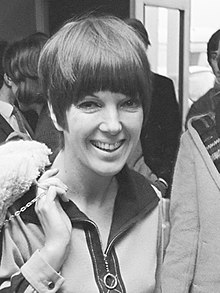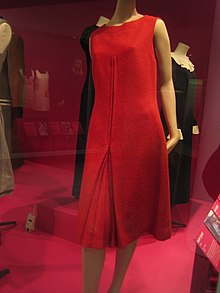Mary Quant
From Wikipedia, the free encyclopedia
| Mary Quant, OBE | |
|---|---|

Mary Quant (1966)
|
|
| Born | 11 February 1934 Blackheath, London, England |
| Nationality | Anglo-Welsh |
| Education | Goldsmith's College |
| Occupation | Fashion designer |
| Awards | OBE, FCSD |
| Labels | Mary Quant |
| Website | |
| www.maryquant.co.uk | |
Contents
Early life
Quant was born in Blackheath, southeast London, on 11 February 1934, the daughter of Welsh teachers.[7] Her parents, Jack and Mary Quant, were both from mining families. They had been awarded scholarships to grammar school and had both attained first-class degrees at Cardiff University, before moving to London to work as schoolteachers.[8] Quant went to Blackheath High School, then studied illustration at Goldsmiths College. After gaining a Diploma in Art Education from Goldsmiths, Quant began an apprenticeship at Erik, a high-end Mayfair milliner on Brook Street next door to the Claridge's hotel.[8][9][10]She met her future husband and business partner, Alexander Plunket Greene in 1953.[10] They were married from 1957 until his death in 1990, and had a son, Orlando (b. 1970).
Fashion career

A 1960 Mary Quant dress, on display at the Victoria & Albert Museum, London
Early career
In November 1955, Quant and Plunket Greene teamed up with a photographer and former solicitor, Archie McNair, to open Quant's first shop on the King's Road in London called Bazaar, above "Alexander's", a basement restaurant run by Plunket Green.[10][11] In 1957, they opened the second branch of Bazaar, which was designed by Terence Conran.[8][11]Successful designs from this early period included small white plastic collars to brighten up sweaters and dresses, bright stockings in colours matched to her knitwear, men's cardigans made long enough to be worn as dresses, and a pair of "mad" lounging pyjamas made by Quant herself which were featured in Harper's Bazaar and purchased by an American manufacturer to copy.[11] Following this, Quant decided to design and make more of the clothes she stocked, instead of buying in stock.[11] Initially working solo, she was soon employing a handful of machinists, and by 1966 she was working with eighteen manufacturers[citation needed] concurrently.
Quant and the miniskirt
The miniskirt, described as one of the defining fashions of the 1960s,[12] is one of the garments most widely associated with Quant. Whilst she is often cited as the inventor of the style, this claim has been challenged by others. Marit Allen, a contemporary fashion journalist and editor of the influential "Young Ideas" pages for UK Vogue, firmly stated that John Bates, rather than Quant or André Courrèges, was the original creator of the miniskirt.[13] Others credit Courrèges with the invention of the style.[14] However, skirts had been getting shorter since the 1950s — a development Mary Quant considered practical and liberating, allowing women the ability to run for a bus.[15]Quant later said "It was the girls on the King's Road who invented the mini. I was making easy, youthful, simple clothes, in which you could move, in which you could run and jump and we would make them the length the customer wanted. I wore them very short and the customers would say, 'Shorter, shorter.'" [8] She gave the miniskirt its name, naming it after her favorite make of car, the Mini.[16]
In addition to the miniskirt, Quant is often credited with inventing the coloured and patterned tights that tended to accompany the garment, although their creation is also attributed to the Spanish couturier Cristóbal Balenciaga who offered harlequin-patterned tights in 1962[14][17] or to John Bates.[18]
Later career
In the late 1960s, Quant popularised hot pants, becoming a British fashion icon.[19][20] Through the 1970s and 1980s she concentrated on household goods and make-up, rather than just her clothing lines, including the duvet which she claims to have invented.[10]In 1988, Mary Quant designed the interior of the Mini (1000) Designer (originally dubbed the Mini Quant, the name was changed when popularity charts were set against having Quant's name on the car).[citation needed] It featured black and white striped seats with red trimming. The seatbelts were red, and the driving and passenger seats had Quant's signature on the upper left quadrant. The steering wheel had Quant's signature daisy and the bonnet badge had "Mary Quant" written over the signature name. The headlight housings, wheel arches, door handles and bumpers were all nimbus grey, rather than the more common chrome or black finishes. Two thousand were released in the U.K. on 15 June 1988, and a number were also released on to foreign markets; however, the numbers for these are hard to come by. The special edition Mini came in two body colours, jet black and diamond white.
She is also a Fellow of the Chartered Society of Designers, and winner of the Minerva Medal, the Society's highest award.
In 2000, she resigned as director of Mary Quant Ltd., her cosmetics company, after a Japanese buy-out.[21] There are over 200 Mary Quant Colour shops in Japan, where Quant fashions continue to enjoy more popularity.
Awards
In 1963 Quant was the first winner of the Dress of the Year award.In 1966 she was appointed OBE for her outstanding contribution to the fashion industry. She arrived at Buckingham Palace to accept the award in a cream wool jersey minidress with blue facings.[22]
In 1990 she won the Hall of Fame Award of the British Fashion Council.
Books by Quant
- 1966: Quant by Quant — her first autobiography
- 1984: Colour by Quant
- 1986: Quant on Make-up
- 1999 Classic Make-up and Beauty Book
- 2011 Mary Quant: Autobiography — her second autobiography.
No comments:
Post a Comment
Please leave a comment-- or suggestions, particularly of topics and places you'd like to see covered